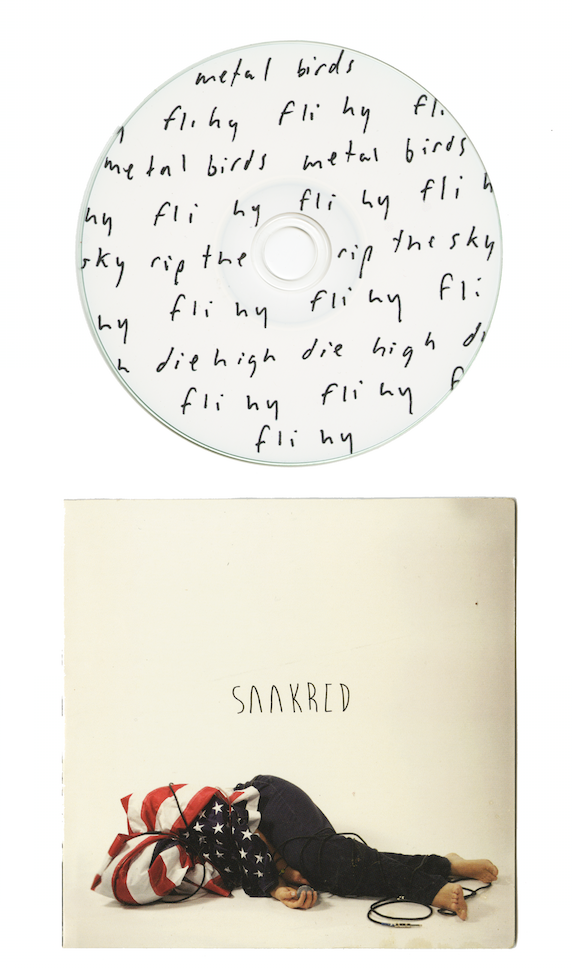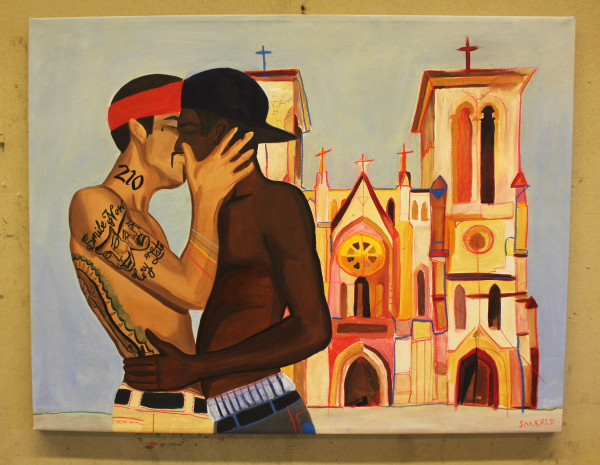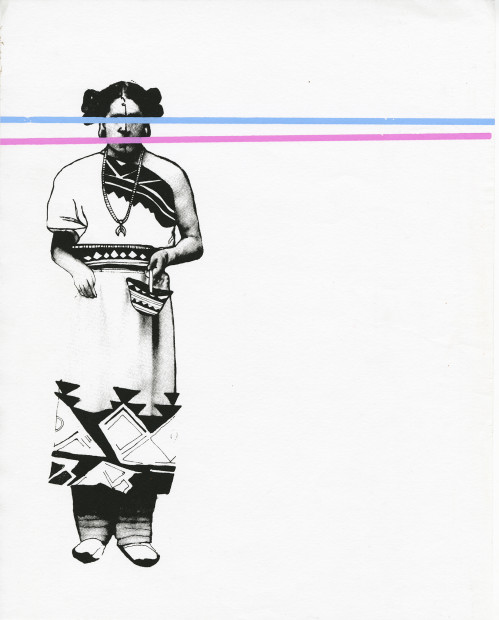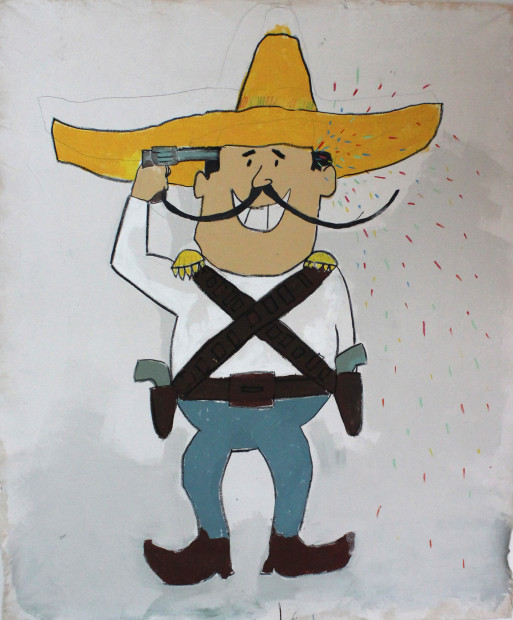Saakred is a 26-year-old queer/trans artist, musician, filmmaker, and community activist living in San Antonio. The artist’s paintings are a collection of cultural stereotypes, queer Chicano experiences, and it stems from traditional folk art of South Texas. Saakred’s first solo show “Sad Boy Church: Original Works” is currently on view at the Esperanza Peace & Justice Center. I spoke with Saakred about the artist’s relationship to music, art, and politics.
VS: Politics are obviously at the forefront of your work. Tell me more about your activism.
S: My first politicization was the experience of growing up poor, watching mom work day and night, for all my life just to make ends meet. Poor, working-class, children of immigrants know firsthand the injustice of the church and state. I think my mom non-intentionally passed that knowledge on to me, serving as a platform for progressive, radical, ideology. Since then, I’ve always dreamt of using art for social justice but this is the first time I’m actually able to it.
VS: How does your identity influence your art?
S: When I performed [music] in galleries I wasn’t imitating anything. I was creating what I wish existed. I don’t feel like there are a lot of spaces in San Antonio where I feel comfortable. Right now the idea of me leaving San Antonio is because I can’t create that space for me to feel comfortable in. I need to find those other spaces that have already been created in other places so I can know what it feels like. Right now I feel alienated.

VS: Tell me a bit about you work as a performer.
S: With art the first thing that comes to mind is the tangibility and immediacy of a mark on a white surface versus a sound in the air. That’s what really attracted me about entering this world. We live in a visual world. Most people don’t relate to the world through sound. The more immediate sensation is based on what you see. This show is me figuring out what my style is.
Music was not planned at all. It was very much about proving that I was better than any of the boys or bands that were out there. When I was 18 I had my first electric guitar and I had a tiny amp. My sound was super-distorted, with dark, slow, droney sounds. It became this thing to conquer so I stayed up for a week straight just learning how to program a synthesizer. I considered my first electronic work as punk—as resistance—and then it just kind of spiraled out. It became this obsession of how confrontational can you get. But I saw this performance from the Houston performer, B L A C K I E, and he changed my life. He was dressed in drag and after the show I went and talked to him. He was super weird and not what I expected. He changed the way I understood performance art. I adopted some of that and started to explore with my body and with video projections.
VS: Tell me about your transition to art.
S: Everything [in my mind] in the art world feels a lot more gentle. When I’m creating my work I can take as much time as I want and I don’t have to perform. I can just install it on a wall, secretly, in the night. I can sit back and enjoy someone viewing my work.
One thing that I wanted to happen with art was to have a conversation. Not once [as a musician] did anyone ever talk to me about what I was doing. When I put my painting Jotos in Love on the wall and this woman from NALAC [National Association for Latino Arts and Culture] came in and looked at it, she had this whole conversation with me about post-colonialism, homophobia, and the church. This was the first time I ever put my painting up and it was this whole other world of intellect. It was beyond people getting drunk at a bar.
How does your queer identity influence your art and music?
S: I don’t think there’s a queer-owned gallery in San Antonio [I’m not an expert] but it seems very male-dominated. There’s this group of Chicano men that run the galleries but they’re also really supportive. It’s more accessible for a woman to make art and have a show than being in a rock band. It was a struggle for them [the Esperanza] to agree to do this show but I’m super glad. Now that being gay is super-cool, the Jotos in Love piece is not that controversial. This [Esperanza] is also one of the few spaces in San Antonio that has a history of queer organizing.
In the music world it’s intimidating and in some ways dehumanizing. It was always about fighting and resisting. I feel like I’ve had enough affirmation about the importance of what I’m doing. I think now there’s the understanding where my place is as trans. It’s still something that I’m trying to be proud of and be clear of but mostly I’m not just my gender, I’m a human being. I have a body and a heart and I care about politics.
What are some of your future plans as an artist?
S: I’m going to be studying art at the Burren College of Art in Ireland for about four months and spend a month traveling in Europe looking for other queer, trans, and activist communities, but also playing shows. The goal in Ireland is to really focus on a body of work, and use the time to write and hopefully record a new album somewhere in Europe.
“Sad Boy Church: Original Works” runs through Friday, August 14 at the Esperanza Peace & Justice Center, 922 San Pedro Avenue, San Antonio, Texas 78212.







